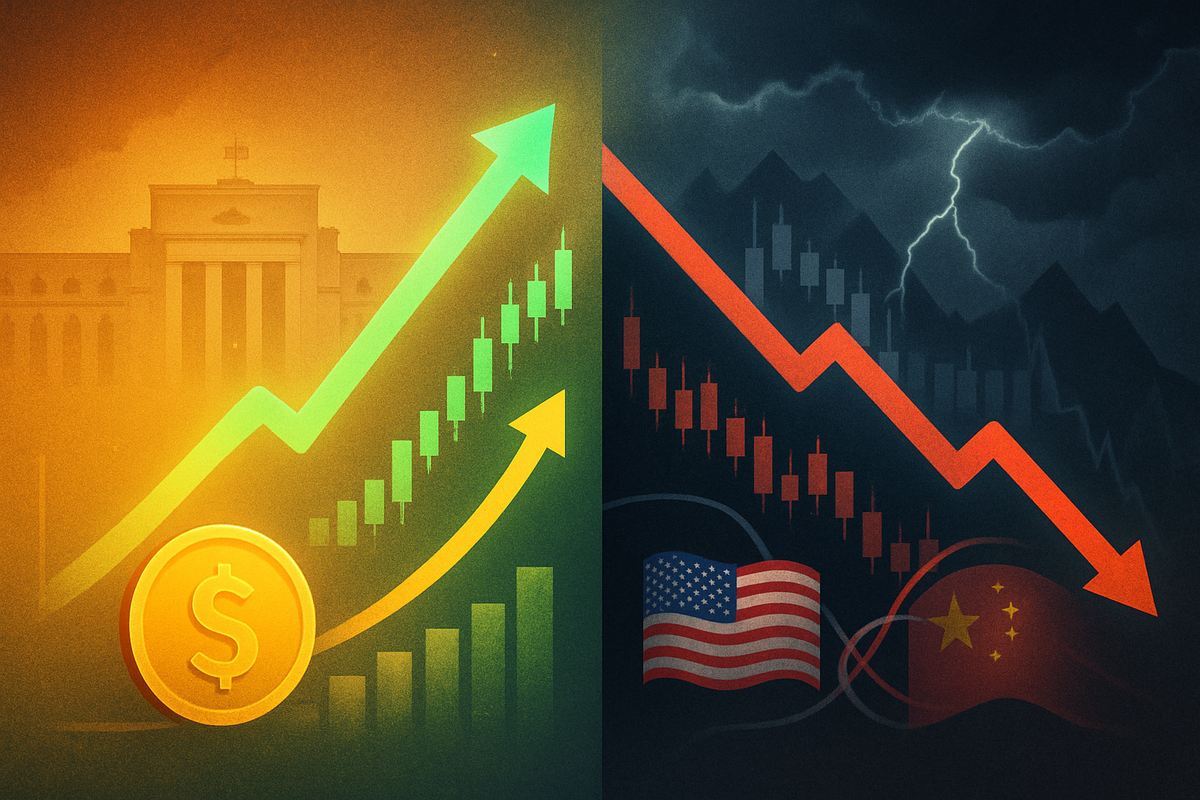
October 14, 2025 – The financial markets find themselves at a critical juncture today, grappling with conflicting signals that have created a volatile landscape for investors. While Federal Reserve Chair Jerome Powell's recent comments had initially fueled expectations of a pivot towards a "risk-on mode," signaling an increased appetite for higher-yielding assets, the market's immediate reaction has been anything but straightforward. Fresh U.S.-China trade tensions have quickly overshadowed the dovish monetary policy outlook, plunging major indices into a "risk-off" environment by the close of trading on October 14, 2025.
This intricate interplay of monetary policy expectations and geopolitical realities has left investors navigating a complex path. The anticipation of interest rate cuts typically encourages a shift towards growth-oriented investments, yet the resurgence of trade hostilities has prompted a flight to safety, highlighting the fragility of market sentiment in the face of global uncertainties.
A Whiff of "Risk-On" Doused by Geopolitical Storms
The term "risk-on mode" describes a market environment where investor confidence is high, leading to a greater willingness to invest in assets with higher potential returns, such as equities, particularly in growth sectors, and high-yield bonds. Conversely, "risk-off mode" sees investors retreating to safer assets like government bonds, gold, and defensive stocks during periods of uncertainty.
The initial impetus for a "risk-on" shift stemmed from Federal Reserve Chair Jerome Powell's recent pronouncements. On October 14, 2025, Powell explicitly stated that a significant slowdown in hiring presented a growing risk to the U.S. economy, hinting at the likelihood of two more interest rate cuts before the year's end. He underscored the Fed's heightened concern for the job market over inflation, despite tariffs nudging the Fed's preferred inflation measure to 2.9%. Market participants quickly began pricing in a 25-basis-point rate cut at the upcoming October 28-29 FOMC meeting, with strong expectations for another in December, potentially bringing the federal funds rate closer to 3% by year-end. These expectations of lower borrowing costs typically act as a catalyst for increased risk-taking. However, it's worth noting that in a speech on September 23, 2025, Powell had also offered a more cautious outlook, noting moderation in economic growth, slowed consumer spending, and weakness in the housing sector, even commenting that "equity prices are fairly highly valued," hinting at potential "bubble territory."
Despite the dovish undertones from the Fed, the market's immediate reaction on October 14, 2025, was a sharp pivot to "risk-off." This abrupt shift was primarily triggered by escalating U.S.-China trade tensions, as Beijing imposed new sanctions and export curbs, reigniting fears of economic retaliation and a global slowdown. The Dow Jones Industrial Average plummeted over 500 points, while the S&P 500 (NYSE: SPY) and Nasdaq Composite (NASDAQ: QQQ) also experienced significant declines. The Cboe Volatility Index (VIX), often referred to as the market's "fear gauge," spiked above 22, signaling renewed investor anxiety. This highlights how swiftly geopolitical developments can override monetary policy signals, pushing the market into a defensive posture.
Navigating the Crosscurrents: Potential Winners and Losers
In a pure "risk-on" environment, propelled by the prospect of lower interest rates, growth-oriented sectors and companies typically stand to benefit the most. Technology giants like Apple Inc. (NASDAQ: AAPL), Microsoft Corp. (NASDAQ: MSFT), and NVIDIA Corp. (NASDAQ: NVDA), along with consumer discretionary companies such as Amazon.com Inc. (NASDAQ: AMZN) and Tesla Inc. (NASDAQ: TSLA), would likely see increased investor interest due to their future earnings potential being discounted at a lower rate. Smaller-cap companies and emerging markets also tend to thrive as investors seek higher returns. Conversely, traditional safe-haven assets and defensive stocks, such as utilities like NextEra Energy Inc. (NYSE: NEE) or consumer staples like Procter & Gamble Co. (NYSE: PG), might see capital rotation out of them.
However, the actual market dynamics on October 14, 2025, painted a different picture. The sudden resurgence of U.S.-China trade tensions immediately shifted the narrative to "risk-off," causing a broad-based sell-off. In this scenario, the very tech and AI stocks that had previously driven market rallies, such as NVIDIA and other semiconductor companies, led the downturn as investors feared the impact of trade restrictions on global supply chains and consumer demand. Companies heavily reliant on international trade, particularly those with significant exposure to the Chinese market, face immediate headwinds. This includes industrial giants like Caterpillar Inc. (NYSE: CAT) and various luxury goods retailers.
While defensive sectors might typically offer some resilience in a "risk-off" environment, the suddenness and nature of the geopolitical shock meant that even these saw some pressure as overall market sentiment deteriorated. The U.S. Dollar, despite expectations of rate cuts, could ironically strengthen as a safe-haven currency if global uncertainty persists, impacting multinational corporations with significant international revenue. The immediate losers are broadly those with high growth expectations and international exposure, while the "winners" are those who managed to shed risk quickly, or those holding assets perceived as ultimate safe havens amidst escalating global tensions.
Wider Significance: A Confluence of Monetary Policy and Geopolitics
The current market environment underscores a profound shift where monetary policy, while influential, is increasingly contending with powerful geopolitical forces. Federal Reserve Chair Powell's dovish stance reflects a broader trend among central banks to balance inflation concerns with the imperative of maintaining economic growth and employment. The potential rate cuts signal a proactive approach to prevent a deeper economic downturn, aligning with a global trend of central banks leaning towards accommodative policies in the face of slowing growth and persistent, albeit sometimes supply-side driven, inflation.
However, the immediate impact of the renewed U.S.-China trade tensions highlights the fragility of this monetary policy framework. Such trade disputes have far-reaching ripple effects, impacting global supply chains, increasing production costs, and potentially dampening consumer demand worldwide. Companies like Boeing Co. (NYSE: BA), heavily reliant on international orders, or semiconductor manufacturers such as Taiwan Semiconductor Manufacturing Co. (NYSE: TSM), which operate within a complex global ecosystem, face significant disruptions. Partners and competitors across various industries will need to re-evaluate their strategies, potentially leading to diversification of supply chains away from China or a renewed focus on domestic markets.
Historically, periods of significant monetary policy shifts combined with escalating trade conflicts have often led to heightened market volatility and economic uncertainty. The trade wars of the late 2010s, for instance, demonstrated how tariffs and retaliatory measures could significantly impact corporate earnings and investor confidence, even amidst generally strong economic fundamentals. Regulatory implications could include new tariffs, export controls, and increased scrutiny on foreign investments, forcing companies to adapt to a rapidly changing international trade landscape. This current situation is a stark reminder that even well-communicated monetary policy intentions can be quickly overshadowed by external shocks, demanding a more comprehensive risk assessment from investors.
What Comes Next: Navigating Uncertainty
The immediate future for the markets will be shaped by the interplay of two dominant forces: the Federal Reserve's next moves and the trajectory of U.S.-China trade relations. In the short term, investors will be keenly watching the upcoming FOMC meeting at the end of October for the anticipated 25-basis-point rate cut, as well as any further guidance from Chair Powell. Simultaneously, headlines regarding U.S.-China negotiations, potential further sanctions, or de-escalation efforts will dictate daily market sentiment. Should rate cuts materialize as expected, it could provide some underlying support to equity markets, potentially reigniting a "risk-on" appetite, especially if trade tensions ease.
In the long term, companies will need to consider strategic pivots and adaptations. Diversifying supply chains, exploring new markets, and investing in domestic production capabilities may become imperative for those heavily exposed to geopolitical risks. For investors, this environment presents both challenges and opportunities. While volatility is likely to persist, creating potential for sharp corrections, it also opens doors for tactical entries into undervalued assets. Sectors that demonstrate resilience to trade shocks or benefit from domestic policy shifts could emerge as strong performers.
Potential scenarios range from a "Goldilocks" outcome where the Fed successfully engineers a soft landing through rate cuts and trade tensions de-escalate, leading to a sustained market recovery, to a more adverse scenario where trade conflicts intensify, leading to a global economic slowdown and further market contractions. Investors should prepare for continued uncertainty, focusing on companies with strong balance sheets, diversified revenue streams, and a clear strategic response to global geopolitical shifts. The market will remain a battleground between the fundamental desire for growth and the overarching need for safety.
A Market at a Crossroads: Key Takeaways
The market's current state is a vivid illustration of the complex forces that shape financial outcomes. While Federal Reserve Chair Jerome Powell's dovish comments provided a clear signal of potential monetary easing, aiming to steer the economy into a "risk-on" mindset, the resurgence of U.S.-China trade tensions on October 14, 2025, swiftly redirected market sentiment into a defensive "risk-off" posture. This dynamic highlights that while central bank policies are crucial, they are not the sole determinants of market direction; geopolitical events can quickly become overriding factors.
Moving forward, the market will likely remain highly sensitive to both economic data, particularly employment figures and inflation reports that influence Fed decisions, and developments on the international trade front. Investors must understand that the market is currently at a crossroads, where the promise of lower borrowing costs clashes directly with the specter of global economic fragmentation. The immediate future will test the resilience of corporate earnings and the conviction of investors.
For the coming months, investors should remain vigilant. Key watchpoints include the outcomes of upcoming FOMC meetings, any statements or actions regarding U.S.-China trade, and the quarterly earnings reports of major corporations, which will offer insights into how businesses are navigating these dual challenges. A balanced portfolio, strategic diversification, and a keen eye on global headlines will be essential for navigating what promises to be a continuously evolving and potentially turbulent market landscape.
This content is intended for informational purposes only and is not financial advice





